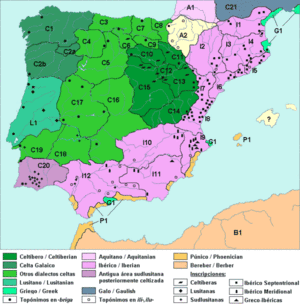|
Lenguas paleohispánicas
 Pueblos paleohispánicos C1: Galaicos / C2b: Brácaros / C3: Cántabros / C4: Astures / C5: Vacceos / C6: Turmogos / C7: Caristios / C8: Várdulos / C9: Berones / C10: Pelendones / C11: Belos / C12: Lusones / C13: Titos / C14: Olcades / C15: Arevacos / C16: Carpetanos / C17: Vetones / C18-C19: Célticos / C20: Conios / L1: Lusitanos / I1: Ceretanos / I2: Ilergetes / I3: Lacetanos / I4: Indigetes / I5: Layetanos / I6: Ilercavones / I7: Sedetanos / I8: Edetanos / I9: Contestanos / I10: Oretanos / I11: Bastetanos / I12: Turdetanos / G21: Galos / G1: Griegos / P1: Fenicios/Cartagineses / B1: Bereberes.  Se llaman lenguas paleohispánicas o prerromanas a las lenguas indígenas habladas en la península ibérica antes de la llegada de los romanos. Es controvertido el uso del término "indígenas", puesto que no se conoce el origen de algunas de estas lenguas y otras son indoeuropeas, pero delimita el grupo de lenguas tratado frente al fenicio, al griego y naturalmente frente al latín. Muy probablemente, la mayoría de las lenguas paleohispánicas desaparecieron sin dejar rastro, pero de algunas se han conservado inscripciones en escrituras paleohispánicas y en alfabeto latino que se datan como mínimo desde el siglo V a. C. , quizás desde el siglo VII a. C., hasta finales del siglo I a. C. o principios del siglo I a. C. Estas lenguas se denominan lenguas en ruinas o residuales (en alemán Restsprachen o Trümmersprachen) como el etrusco, el paleosardo, el ligur y el rético entre otras. Lenguas documentadasLas lenguas paleohispánicas de las que se conocen textos escritos son:
Lenguas indirectamente conocidasOtras sólo se conocen a través de topónimos, antropónimos y teónimos conocidos a través de las fuentes griegas y romanas o de inscripciones en lengua latina:
Diversidad lingüísticaLos datos de diversidad lingüística de otras regiones del planeta antes de la formación de Estados centralizados como la antigua Italia o antigua Grecia, que están algo mejor documentados que la península ibérica en época antigua, muestran para estas regiones una diversidad lingüística elevada. La diversidad lingüística de Italia con 23 lenguas en unos 300 000 kilómetros cuadrados es comparable a la diversidad lingüística de las lenguas indígenas prehispánicas de países andinos, como Colombia, Ecuador o Perú.[3] Si el grado de diversidad lingüística en la península ibérica hubiera sido similar al de Italia, cabría esperar entre 30 y 45 lenguas en toda la Península. Por esa razón podría preguntarse hasta qué punto las diferentes variedades de íbero eran mutuamente inteligibles, cuántas lenguas célticas pudieron coexistir o si las inscripciones solo representan una pequeña parte de la variedad lingüística realmente existente. Véase tambiénReferencias
Bibliografía
Enlaces externos |
||||||||||||||
